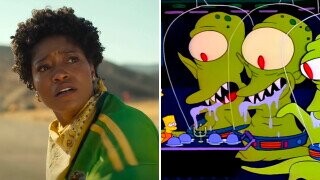'Nope' And Every Other Jordan Peele Movie Can Be Explained By 'The Simpsons'

This article contains SPOILERS for Nope … also every other Jordan Peele movie … and some pretty old episodes of The Simpsons.
The number one movie at the box office this weekend was, unsurprisingly, Jordan Peele’s Nope – which, it turns out, is basically a modern reworking of Jaws, but with a flying saucer-like creature instead of a shark … and also a bloodthirsty ‘80s sitcom chimp for some reason. At one point, late into the movie, Daniel Kaluuya’s character OJ realizes that the alien won’t gobble him up if he averts his eyes and doesn’t actually look at it. This particular plot point may have seemed familiar – and not just for audience members who had it spoiled for them by the last trailer.
Don't Miss
As others have pointed out, this development is not unlike what happens in The Simpsons’ “Treehouse of Horror VI,” specifically the “Attack of the 50-Foot Eyesores” segment in which giant advertisements come to life and terrorize Springfield. The only way to conquer the rogue commercials is to ignore them. Nope seems to be making a similar commentary on the destructive potential of our obsession with spectacle; the only way to stop it is to not engage in it. Sadly, Peele didn’t employ the services of crooner Paul Anka for the finale.
This isn’t exactly an isolated occurrence; each of Peele’s films have contained twists that connect in some way to classic Simpsons episodes. For example, Us, the story of underground doppelgangers bent on getting revenge on their surface-dwelling equals, recalls “The Thing and I” from “Treehouse of Horror VII” – the one where Bart has an evil twin locked in the attic. Both even feature similar twist endings; we learn in Us that our protagonist was really the “Tethered” double the entire time since they switched places as kids –
– and in The Simpsons, it’s revealed that our Bart was the “evil” one all along …
This isn’t to say that The Simpsons was totally charting new territory here; the show’s writers admitted that the story unintentionally paralleled the movie Basket Case and the short story “Born of Man and Woman” by Richard Matheson. But before that, Get Out, too, featured a Simpson-y twist, in which the villains’ surgical schemes are undone by the flash of a camera, which briefly reawakens Lakeith Stanfield’s character Andre.
Which, in the movie, arguably works as a metaphor for the liberating power of art and filmmaking – but it also calls to mind the end of the “Itchy & Scratchy Land” episode, where the Simpson family discovers that camera flashes are the killer robots’ only weakness.
Of course, at this point, claiming that The Simpsons predicted cultural events is both trite and often wildly inaccurate. But now that it’s happened three times, it doesn’t seem out of the realm of possibility that these story choices are part of an intentional homage on Peele’s part. After all, his movies are basically Hot Pockets packed full of gooey hidden meanings and pop-culture references – this is a filmmaker who secretly dressed as Jack Torrance while promoting Us. So really, sneaking in (and elevating) old Simpsons story beats wouldn’t be too out of place.
You (yes, you) should follow JM on Twitter!
Thumbnail: Universal Pictures/20th Century Television